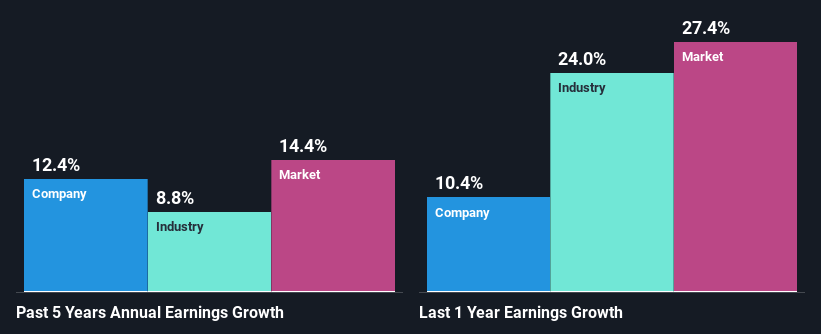Is Parker-Hannifin Corporation's (NYSE:PH) Stock's Recent Performance A Reflection Of Its Financial Health?
Parker-Hannifin's (NYSE:PH) stock up by 4.0% over the past week. Given its impressive performance, we decided to study the company's key financial indicators as a company's long-term fundamentals usually dictate market outcomes. In this article, we decided to focus on Parker-Hannifin's ROE.
Return on equity or ROE is a key measure used to assess how efficiently a company's management is utilizing the company's capital. In short, ROE shows the profit each dollar generates with respect to its shareholder investments.
See our latest analysis for Parker-Hannifin
How Do You Calculate Return On Equity?
The formula for return on equity is:
Return on Equity = Net Profit (from continuing operations) ÷ Shareholders' Equity
So, based on the above formula, the ROE for Parker-Hannifin is:
19% = US$1.7b ÷ US$9.0b (Based on the trailing twelve months to March 2022).
The 'return' is the profit over the last twelve months. That means that for every $1 worth of shareholders' equity, the company generated $0.19 in profit.
What Is The Relationship Between ROE And Earnings Growth?
So far, we've learned that ROE is a measure of a company's profitability. We now need to evaluate how much profit the company reinvests or "retains" for future growth which then gives us an idea about the growth potential of the company. Assuming everything else remains unchanged, the higher the ROE and profit retention, the higher the growth rate of a company compared to companies that don't necessarily bear these characteristics.
A Side By Side comparison of Parker-Hannifin's Earnings Growth And 19% ROE
To begin with, Parker-Hannifin seems to have a respectable ROE. Especially when compared to the industry average of 12% the company's ROE looks pretty impressive. This probably laid the ground for Parker-Hannifin's moderate 12% net income growth seen over the past five years.
As a next step, we compared Parker-Hannifin's net income growth with the industry, and pleasingly, we found that the growth seen by the company is higher than the average industry growth of 8.8%.
Earnings growth is an important metric to consider when valuing a stock. It’s important for an investor to know whether the market has priced in the company's expected earnings growth (or decline). Doing so will help them establish if the stock's future looks promising or ominous. What is PH worth today? The intrinsic value infographic in our free research report helps visualize whether PH is currently mispriced by the market.
Is Parker-Hannifin Making Efficient Use Of Its Profits?
With a three-year median payout ratio of 30% (implying that the company retains 70% of its profits), it seems that Parker-Hannifin is reinvesting efficiently in a way that it sees respectable amount growth in its earnings and pays a dividend that's well covered.
Besides, Parker-Hannifin has been paying dividends for at least ten years or more. This shows that the company is committed to sharing profits with its shareholders. Upon studying the latest analysts' consensus data, we found that the company is expected to keep paying out approximately 27% of its profits over the next three years. Therefore, the company's future ROE is also not expected to change by much with analysts predicting an ROE of 22%.
Conclusion
Overall, we are quite pleased with Parker-Hannifin's performance. In particular, it's great to see that the company is investing heavily into its business and along with a high rate of return, that has resulted in a sizeable growth in its earnings. With that said, the latest industry analyst forecasts reveal that the company's earnings are expected to accelerate. To know more about the company's future earnings growth forecasts take a look at this free report on analyst forecasts for the company to find out more.
Have feedback on this article? Concerned about the content? Get in touch with us directly. Alternatively, email editorial-team (at) simplywallst.com.
This article by Simply Wall St is general in nature. We provide commentary based on historical data and analyst forecasts only using an unbiased methodology and our articles are not intended to be financial advice. It does not constitute a recommendation to buy or sell any stock, and does not take account of your objectives, or your financial situation. We aim to bring you long-term focused analysis driven by fundamental data. Note that our analysis may not factor in the latest price-sensitive company announcements or qualitative material. Simply Wall St has no position in any stocks mentioned.

